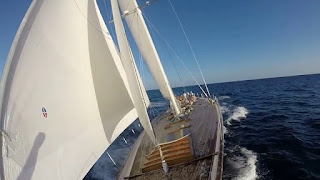Bad start blues
Oops bad start!
It has happened to all sailors, some on a more regular basis
than others it must be said. That horror start where it just doesn’t seem to
happen? It could come down to many factors, which may have been an error of
judgement on your behalf, a malfunction or because of other boats actions (or
sometimes inactions). But we have been there, back in the ruck watching the
other boats sailing away from us. This is usually accompanied by feelings of
disappointment and frustration.
Address the issue
It is so very important not to wallow in self-pity but to
look at ways to overcome the problem. Whilst there is no doubt that a loss has
been made. It is our immediate priority to minimise the loss and try and get
back into the race. We can look at the factors that caused the bad start later
and rectify them for the future, no point bawling out the crew for that
override on the winch when you need to be in recovery mode. We can’t change the
past but can learn from it. It’s just spilt milk!
Get over it, get speed
and get clear
The main thing is to get the boat moving and get out into
clear air. Chances are you will be stuck in disturbed air and falling down
across sterns. Don’t panic and try and pinch with everyone else but get the
speed up, even if it means sailing low with cracked sheets, just get moving!
Look around for the closest way to clear air, we will usually have to tack to
get clear as often a sizeable number of the fleet will continue along on
starboard tack. So tack and get out in
clear air even if it means dipping other boats, just get to clear air as
quickly as possible. On the odd instance the fleet may be tacking off early due
to a wind-shift or a biased course, the closest way to clear unencumbered wind
may be to keep going, but once clear, reassess the situation and work from
there. If you are pinching or trying to point with the front row and as a
result slow through the water, you will be doing a down speed tack and will
lose further ground. Throw in another unplanned down speed tack to a starboard
tacker you can’t dip or a mark you can’t lay and you will in all likelihood be
stopped dead in the water. While the
rest of the fleet races away literally leaving you in their wake.
Don’t wait for a
miracle
There is a moment in all bad starts that we realise it is
all going wrong, we have lost control of the situation. The earlier we
recognise this, the sooner we can get into our recovery plan and minimise the
loss. If you are struggling with no hope of getting up to the line, pinned
above or below it and stuck in bad air with time to go. Then use that time to
bear off, build speed and head toward clear air. Sitting there with no hope until
the gun goes is just an exercise in frustration. Miracles don’t happen! If you
wake up early enough and bale out you may be able to turn a potential shocker
into an average start. Following that you will be well toward minimising the
damage. If you can recognise the inevitable outcome with 30 seconds to go, you
can use that 30 seconds to get out and begin to reposition. You will be a lot
better off than waiting for the gun to go.
Grind it back
If we have lost a significant amount of distance early in
the race, it is important to remember our race is not over. We have made our
day a lot harder but not impossible. Don’t try and get all the ground lost back
in one big grab by taking a flyer or risk. There is still a lot of race to
unfold and many things may occur. By having a bad start we have set ourselves back
and for a while will have to be reactive to other boats in our strategy and
tactics. Once the fleet opens up and we get settled we can begin to try and be
a bit more proactive in our decision making. Looking up at the boats ahead
sailing the shifts can be beneficial in narrowing the gap. Invariably a few
leaders that got away well will be very hard to haul back. But particularly in
larger fleets there are generally clumps of boats being a nuisance to each
other and slowing boats down and wide at marks etc. Opportunities may arise
where you can haul back significant numbers. Just keep focussed and look to
work your way back into the race.
As a coach I quite often point out to sailors that the races
that start badly and end with a reasonable result are the races that win you
regattas. The race where you lead all day is the most memorable and satisfying.
But the race that you fight back in is more a testament to ability, level
headedness and focus. In a regatta or a series, we are simply trying to finish
with as few points on the board as we can. By limiting the loss after a bad
start and we can go a long way toward achieving this.
So don’t lose your cool or give up, just remember the race
is from here onwards.




Comments
Post a Comment